NVIDIA's GeForce GTX 580: Fermi Refined
by Ryan Smith on November 9, 2010 9:00 AM ESTCompute and Tessellation
Moving on from our look at gaming performance, we have our customary look at compute performance, bundled with a look at theoretical tessellation performance. Unlike our gaming benchmarks where NVIDIA’s architectural enhancements could have an impact, everything here should be dictated by the core clock and SMs, with shader and polymorph engine counts defining most of these tests.
Our first compute benchmark comes from Civilization V, which uses DirectCompute to decompress textures on the fly. Civ V includes a sub-benchmark that exclusively tests the speed of their texture decompression algorithm by repeatedly decompressing the textures required for one of the game’s leader scenes.
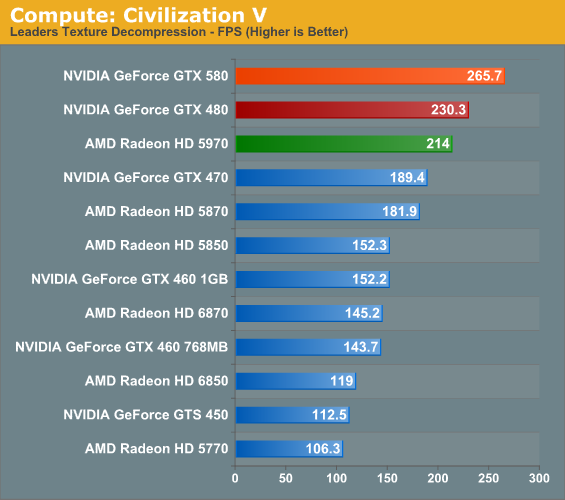
We previously discovered that NVIDIA did rather well in this test, so it shouldn’t come as a surprise that the GTX 580 does even better. Even without the benefits of architectural improvements, the GTX 580 still ends up pulling ahead of the GTX 480 by 15%. The GTX 580 also does well against the 5970 here, which does see a boost from CrossFire but ultimately falls short, showcasing why multi-GPU cards can be inconsistent at times.
Our second compute benchmark is Cyberlink’s MediaEspresso 6, the latest version of their GPU-accelerated video encoding suite. MediaEspresso 6 doesn’t currently utilize a common API, and instead has codepaths for both AMD’s APP (née Stream) and NVIDIA’s CUDA APIs, which gives us a chance to test each API with a common program bridging them. As we’ll see this doesn’t necessarily mean that MediaEspresso behaves similarly on both AMD and NVIDIA GPUs, but for MediaEspresso users it is what it is.
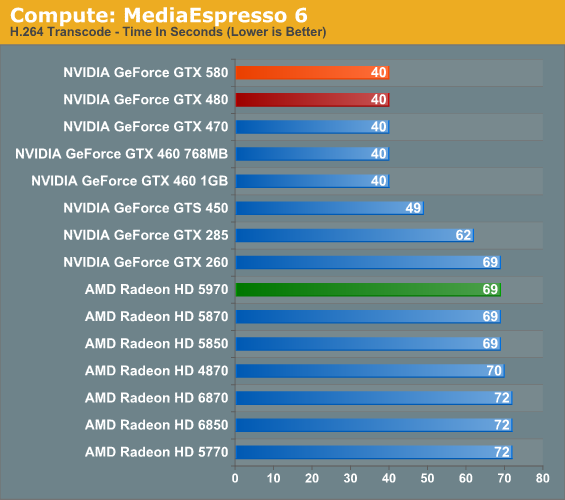
We throw MediaEspresso 6 in largely to showcase that not everything that’s GPU accelerated is GPU-bound, as ME6 showcases this nicely. Once we move away from sub-$150 GPUs, APIs and architecture become much more important than raw speed. The 580 is unable to differentiate itself from the 480 as a result.
Our third GPU compute benchmark is SmallLuxGPU, the GPU ray tracing branch of the open source LuxRender renderer. While it’s still in beta, SmallLuxGPU recently hit a milestone by implementing a complete ray tracing engine in OpenCL, allowing them to fully offload the process to the GPU. It’s this ray tracing engine we’re testing.
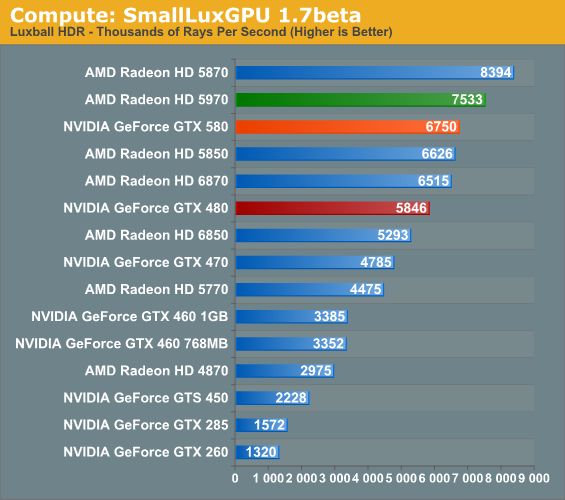
SmallLuxGPU is rather straightforward in its requirements: compute and lots of it. The GTX 580 attains most of its theoretical performance improvement here, coming in at a bit over 15% over the GTX 480. It does get bested by a couple of AMD’s GPUs however, a showcase of where AMD’s theoretical performance advantage in compute isn’t so theoretical.
Our final compute benchmark is a Folding @ Home benchmark. Given NVIDIA’s focus on compute for Fermi and in particular GF110 and GF100, cards such as the GTX 580 can be particularly interesting for distributed computing enthusiasts, who are usually looking for the fastest card in the coolest package. This benchmark is from the original GTX 480 launch, so this is likely the last time we’ll use it.
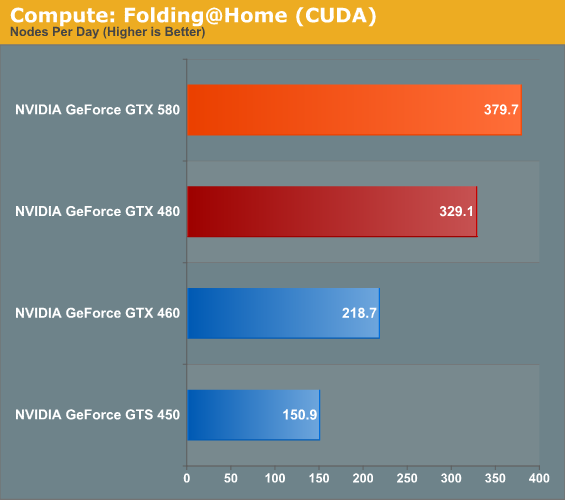
If I said the GTX 580 was 15% faster, would anyone be shocked? So long as we’re not CPU bound it seems, the GTX 580 is 15% faster through all of our compute benchmarks. This coupled with the GTX 580’s cooler/quieter design should make the card a very big deal for distributed computing enthusiasts.
At the other end of the spectrum from GPU computing performance is GPU tessellation performance, used exclusively for graphical purposes. Here we’re interesting in things from a theoretical architectural perspective, using the Unigine Heaven benchmark and Microsoft’s DirectX 11 Detail Tessellation sample program to measure the tessellation performance of a few of our cards.
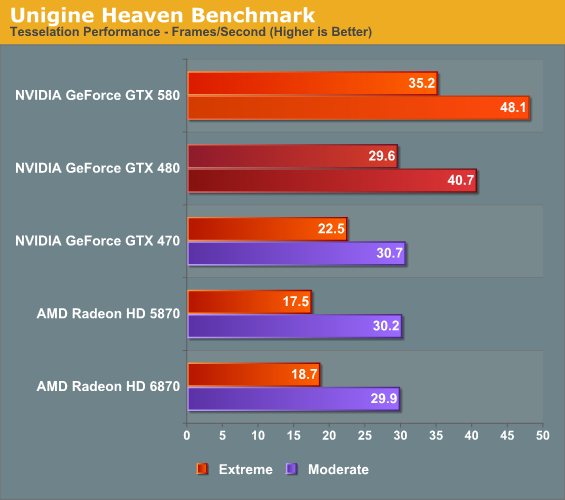
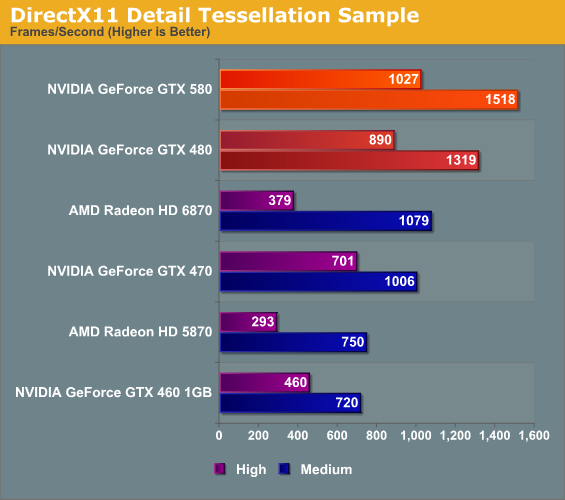
NVIDIA likes to heavily promote their tessellation performance advantage over AMD’s Cypress and Barts architectures, as it’s by far the single biggest difference between them and AMD. Not surprisingly the GTX 400/500 series does well here, and between those cards the GTX 580 enjoys a 15% advantage in the DX11 tessellation sample, while Heaven is a bit higher at 18% since Heaven is a full engine that can take advantage of the architectural improvements in GF110.
Seeing as how NVIDIA and AMD are still fighting about the importance of tessellation in both the company of developers and the public, these numbers shouldn’t be used as long range guidance. NVIDIA clearly has an advantage – getting developers to use additional tessellation in a meaningful manner is another matter entirely.










160 Comments
View All Comments
knutjb - Tuesday, November 9, 2010 - link
I agree guys it should be a 485 not a 580.The 6870 is a sore spot on an otherwise solid refinement. Curious to see its SLI performance. $559 on Newegg this am.
dtham - Tuesday, November 9, 2010 - link
Anyone know if aftermarket cooling for the GTX 480 will work for the GTX 580? It would be great to be able to reuse a waterblock from a GTX 480 for the new 580s. Looking at the picture the layout looks similar.mac2j - Tuesday, November 9, 2010 - link
In Europe the GTX 580 was launched at 399 Euros and in response ATI has lowered the 5970 to 389 Euros (if you believe the rumors).This can only bode well for holiday prices of the 6970 vs 580.
samspqr - Tuesday, November 9, 2010 - link
it's already listed and in stock at alternate.de, but the cheapest one is 480eurthe only 5970 still in stock there is 540eur
yzkbug - Tuesday, November 9, 2010 - link
I moved all my gaming to the living room on a big screen TV and HTPC (a next next gen console in a sense). But, Optimus would be the only way to use this card on HTPC.slatr - Tuesday, November 9, 2010 - link
Ryan,Would you be able to test with Octane Renderer?
I am interested to see if Octane gets throttled.
Thanks
Andyburgos - Tuesday, November 9, 2010 - link
Ryan:I hold you in the most absolute respect. Actually, in my first post a while ago I praised your work, and I think you´re quite didactic and fun to read. On that, thanks for the review.
However, I need to ask you: W.T.F. is wrong with you? Aren´t you pissed off by the fact that GTX480 was a half baked chip (wouldn´t say the same about GTX460) and now that we get the real version they decided to call it 580? Why isn´t a single complain about that in the article?
If, as I understand, you think that the new power / temperature / noise / performance balance has improved dramatically from the 480, I think you are smart enough to see that it was because the 480 was very, very, unpolished chip. This renaming takes us for stupid, is even worse than what AMD did.
/rant
AT & staff, I think you have a duty to tell off lousy tactics such as the Barts being renamed 68x0, or the 8800 becoming 9800 then GTS250 as you always did. You have failed so badly to do that here that you look really biased. For me, a loyal argentinian reader since 2001, that is absolutely imposible, but with the GXT460 and this you are acomplishing that.
+1 for this card deserving an indifferent thumbs up, as Ryan graciously said, not for the card itself (wich is great) but for the nVidia tactics and the half baked 480 they gave us. Remember the FX5800 (as bad or worse than the 480) becoming the 5900... gosh, I think those days are over. Maybe that´s why I stick with my 7300 GT, haha.
I respectfully disent with your opinion, but thanks for the great review.
Best regards,
Andy
ViRGE - Tuesday, November 9, 2010 - link
Huh, are we reading the same article? See page 4.chizow - Tuesday, November 9, 2010 - link
I'd have to agree he probably didn't read the article thoroughly, beside explicitly saying this is the 2nd worst excuse for a new naming denomination, Ryan takes jabs at the 480 throughout by repeatedly hinting the 580 is what Fermi should've been to begin with.Sounds like just another short-sighted rant about renaming that conveniently forgets all the renaming ATI has done in the past. See how many times ATI renamed their R200 and R300 designs, even R600 and RV670 fall into the same exact vein as the G92 renaming he bemoans......
Haydyn323 - Tuesday, November 9, 2010 - link
Nvidia has done no different than ATI has as far as naming in their new cards. They simply jumped on the naming bandwagon for marketing and competetive purposes since ATI had already done so.... at least the 580 is actually faster than the 480. ATI releasing a 6870 that is far inferior to a 5870 is worse in my mind.It should indeed have been a 485, but since ATI calls their new card a 6870 when it really should be a 5860 or something, it only seems fair.